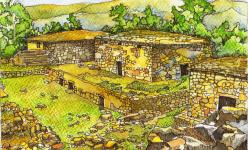Percy Cayetano Acuña Vigil
Pagina organizada por Percy Cayetano Acuna Vigil, esta dedicada a temas de informacion y de discusion del urbanismo, el planeamiento y la arquitectura, enmarcados por mi vision de la filosofia politica.
Se encuentra usted aquí
Ichic Wilcawaín.
Ichik Wilcahuaín.
Huilcahuaín
El arqueólogo peruano Julio C. Tello trabajó en el yacimiento al que bautizó con el nombre que hoy posee (1937); él mismo identificó la cerámica roja y negruzca del lugar, diferenciándola del tipo Huaylas y llamándola Marañón. Posteriormente Wendell Bennett continuó los estudios, descubriendo un cementerio, que dató en el período Tiahuanaco-Huari (1944). En las décadas siguientes no prosperó la investigación al estar cubiertos de escombros los principales recintos del yacimiento.
Cronología
Posiblemente su origen se remonta a unos siglos antes de Cristo, en los comienzos del Intermedio Temprano. Siguió en vigencia durante el Horizonte Medio, probablemente hasta el siglo IX.
Huilcahuaín
Peruvian archaeologist Julio C. Tello worked at the site to which he gave the name it has today (1937 ), he identified the blackish red pottery place , distinguishing the type and calling Marañón Huaylas . Later Wendell Bennett continued his studies , discovering a cemetery , which dates back to the Tiahuanaco - Huari (1944 ) period . In the following decades was unsuccessful research to be covered in the main debris field enclosures .
Chronology
Possibly dating back to several centuries before Christ, at the beginning of the Early Intermediate . It remained in force during the Middle Horizon , probably until the ninth century.
Temple Huilcahuaín
Another view of the Temple of Huilcahuaín .
The main building of the complex has been named "Temple" but in reality it is a mausoleum. It was part of the urban core Huilcahuaín , which must be of considerable size. It was built on a partially filled surface to flatten .
The temple has resemblance to Castle Chavin, although smaller , at its base measures approximately 10.7 by 15.6 m . The masonry walls is a rustic stone pachillas together with mud mortar . It has three floors or platforms connected by stairs and ramps, each floor has its respective input . In total it has 19 interior rooms , five on the first floor , seven in the second , and seven in the third also . It also has a ventilation system of shafts and tunnels . The roof is formed by large slabs tilted twofold. Its height is 9 m .
Recuay Culture Center
Undoubtedly, when the emergence of huaris conquerors (which would have wrought a hypothetical Andean empire from the seventh to tenth centuries AD, with center in Ayacucho) , Huilcahuaín already existed for a long time .
Huilcahuaín might be the last capital of the Recuay culture, before being conquered militarily by the Huari . It also speculates an alliance between the ruling class of the Huari Recuay through royal marriages . The truth is that the late and early Late Intermediate Middle Horizon , coinciding with the cultural expansion Tiahuanaco - Huari , cultural changes are seen in the region of the Callejon de Huaylas. An example of this is the emergence of a different kind of burial. Previously recuayinos used graves in underground galleries , this type of burial was replaced by imposing mausoleums or chullpas , constructs overlapping platforms contain within several chambers or mortuary rooms, the so-called "Temple" of Huilcahuaín would be one of these mausoleums - chullpas where to bury members of the ruling class, with elements of the Tiahuanaco - Huari culture.
Administrative center of Huari
The Huari had Huilcahuaín turn into a center of economic control and administrative member of the network of his empire, is a kind of viceregal capital of Huaylas region (corresponding to the northern highlands of Peru today ) . But we have strong evidence that these attempts to control huari northern Peru collapsed at the end of the eighth century . Important temples and centers of power were then abandoned huari , among which were Huilcahuaín .
Ichic Willkahuaín
Near Huilcahuaín is the archaeological complex of Ichic Willkahuaín , comprised of 15 chullpas , also Huari influence. The turrets chullpas are two to three stories, with several cameras inside designed as collective tombs of the elite, a form of burial which replaced the traditional burial in underground galleries (dating back to the Chavin culture). Excavations between 2005 and 2007 , financed by Barrick Misquichilca have allowed all dating to the year 700 AD, which coincides with the emergence of Huari . Textiles , metalwork , ceramics offering and fulling ( grinding stone ) that were used to crush some kind of product , either for religious rituals or for human consumption were unearthed.
Desarrollado por LLIKA


Comentarios recientes